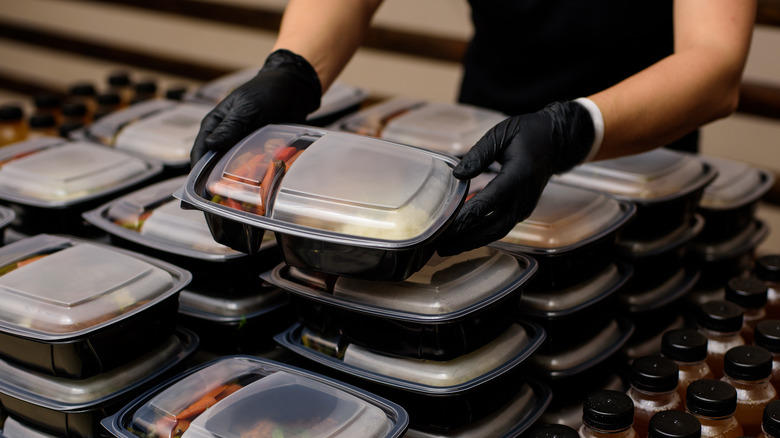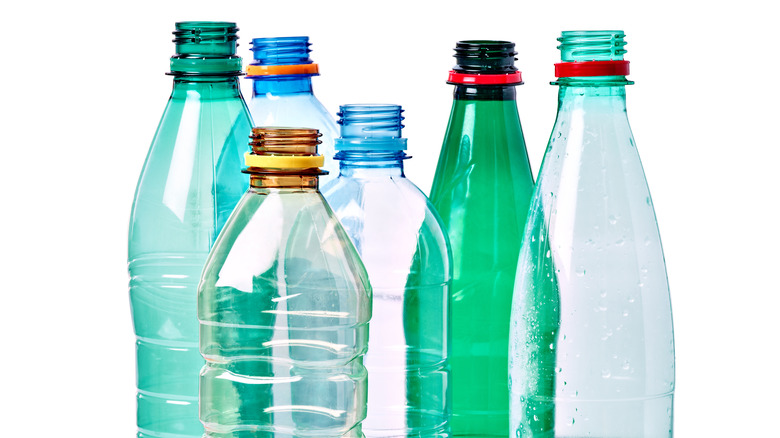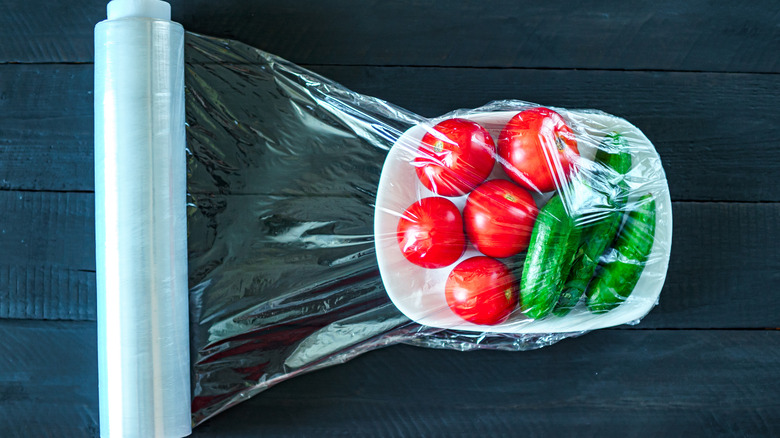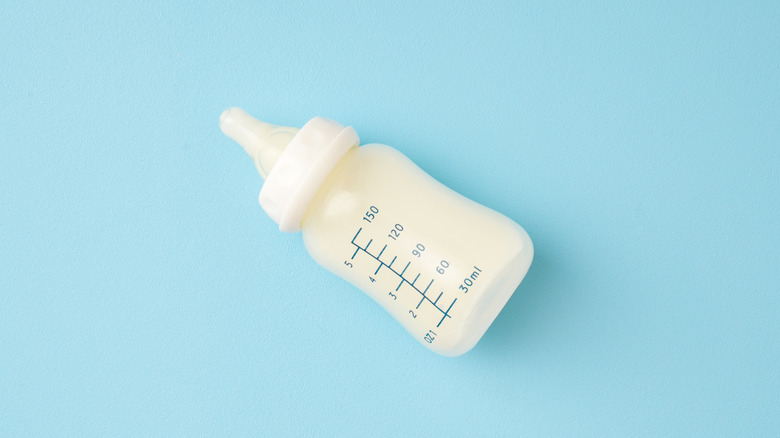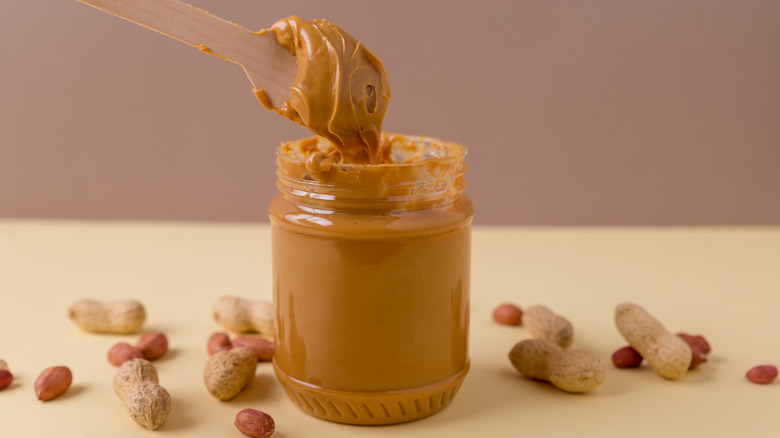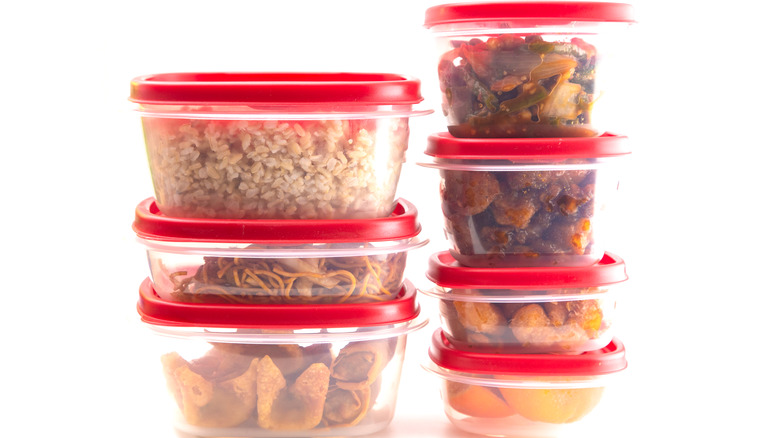The Absolute Best Types Of Plastic For Food Storage
Likely when you think of food storage, your first concern is keeping your food in a way so that it does not spoil and make you sick. You may also be concerned about if the storage container is reusable or recyclable and if it seals well in order to prevent spills and messes. But have you thought about if plastic is safe for food storage?
The Federal Drug Administration created standards by which the production of food, beverages, and drugs is assessed, as well as how it is stored. With so many items stored in plastic — by manufacturers and in homes — it's important to know what plastics are suitable for food storage. The FDA has approved a handful of kinds of plastics that they have determined are safe to keep food.
When evaluating what plastics are safe for food storage, the FDA says it takes into consideration what kind of heat they will be exposed to during the food production process and what kinds of foods will be stored in them, and how that might interact with the plastic (such as acidic tomatoes). After analyzing the different plastics, the FDA has identified a handful that are safe for food storage.
High-Density Polyethylene (HDPE)
If you have anything made of plastic at home, including beverage bottles and butter containers, it's likely made from HDPE, which the FDA says is the most common kind of plastic found in households. Acme Plastics lists such items as plastic bottles, milk jugs, shampoo bottles, cutting boards, and more as uses for HDPE, which is made of petroleum.
According to A&C Plastics, Inc., HDPE has many uses. It can be used to create items made of durable plastic, such as hard hats, and more flexible plastic, such as water bottles. It's also highly recyclable so for companies looking to package their products in recyclable material, HDPE plastic is a top pick. The reason the FDA added it to its list of approved plastics for food storage, according to A&C Plastics, is that it is resistant to mold, mildew, and acid. Another reason that HDPE is suitable for food storage is that it can be sterilized (via Acme Plastics).
Low-Density Polyethylene (LDPE)
If you look, it'll be easy to find items made from LDPE in your home. Common uses for it are plastic wrap and the rings for a six-pack of soda.
According to Toppr, companies like to use LDPE because it is a flexible material that is also strong and does not crack or break easily. Another advantage is that it is fairly inexpensive. LDPE was first widely adopted in the plastics manufacturing industry after World War II, according to Toppr, and then gained widespread usage in food packaging. LDPE is part of the manufacturing process for milk cartons, in which it forms one of the plastic layers. Other non-food uses for LDPE include utensils, pipes, garbage bags, and toys.
When it comes to heating food in LDPE, Toppr advises it's not always the best option. For example, LDPR should not be used for cook-in packs because it can soften. Per the FDA, recycled LDPE is not safe for food packaging; however, when it is in its original state, it is resistant to chemicals and microorganisms. Another plus is it doesn't release toxins when food of different temperatures is stored in LDPE containers.
Polycarbonate (PC)
Packaging that contains liquids often is made from polycarbonate, according to Custom-Pak, which lists water-cooler bottles, baby bottles, and reusable water containers as applications for PC. In recent years, one aspect of PC has come under scrutiny — bisphenol A or BPA. According to the FDA, PDA can be found in the resin from polycarbonate; however, it says its studies have shown that most consumers only ingest a small amount of BPA. What is ingested does not accumulate in a person's body, and therefore, the FDA says there are no known health risks at such a low level.
According to the Mayo Clinic, some studies have shown that BPA can be found in food or beverages that had been stored in containers that had BPA in them, which is a concern because exposure to it might have possible negative health effects. BPA, some believe, can affect the brain and prostate gland of fetuses, infants, and children, as well as children's behavior. Blood pressure, type 2 diabetes, and cardiovascular disease have also been tied to ingesting BPA, according to the Mayo Clinic. Despite these concerns, the FDA has approved PC for food packaging and has created a list of approved polycarbonate sheets that can be used for a variety of purposes, such as hospital trays and water bottles.
Polyethylene Terephthalate (PET)
One of the best plastics food storage, according to the FDA, is PET because it is suitable for holding food products in both its original and recycled states. PET is another very popular choice for food products and can be found in soda bottles, peanut butter jars, salad dressing containers, and much more, per the FDA. In addition, PET is a great option for keeping food because it is durable and repels microorganisms.
Creative Mechanisms also cites that PET is resistant to chemicals and is lightweight, yet strong. PET is a great alternative to glass for food packaging because it does not shatter and is transparent in its natural state. Like glass, however, Creative Mechanisms says that PET is hygienic and fights off bacteria and microorganisms. For companies looking to have a cost-effective product, PET is a good option. Two disadvantages to using PET given by Creative Mechanisms — it is not biodegradable and is affected by oxidation over time.
Polypropylene (PP)
Thinner plastic food containers, such as those for reusable leftover storage, are likely to be made of polypropylene, which the FDA has approved for food use. PP also is used frequently to make single-serve containers, such as yogurt cups. Two big benefits of using plastic containers made of PP are that they will be microwave safe and will not react with the food that is stored in them, even if it's acidic, per the FDA. PP also does not absorb water making it suitable for liquid storage, reports Marlin Steel.
Omnexus describes PP as being strong and inflexible; however, much of the finished product is determined by what additives are incorporated during production. For instance, PP products can be hard or soft, light or heavy, and insulating or conductive, according to Omnexus. In addition to being used for food items, PP is also popular for uses in the automotive, medical, and industrial fields.
